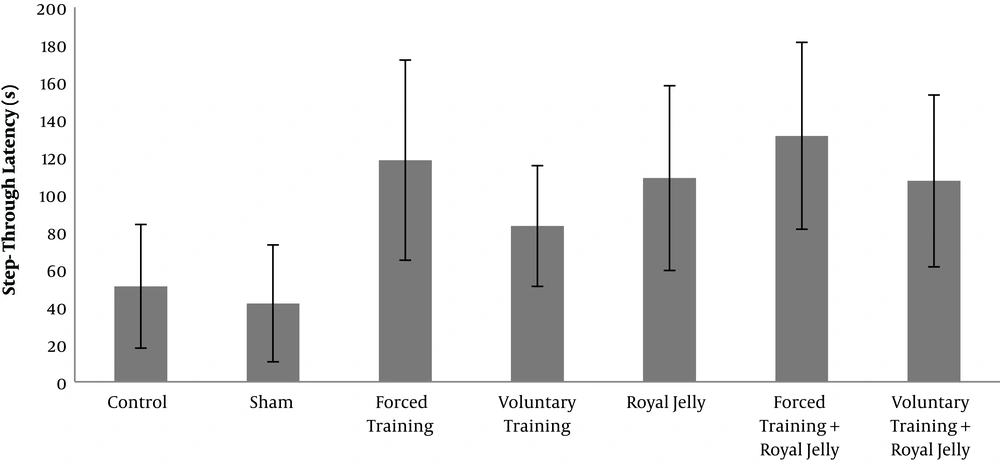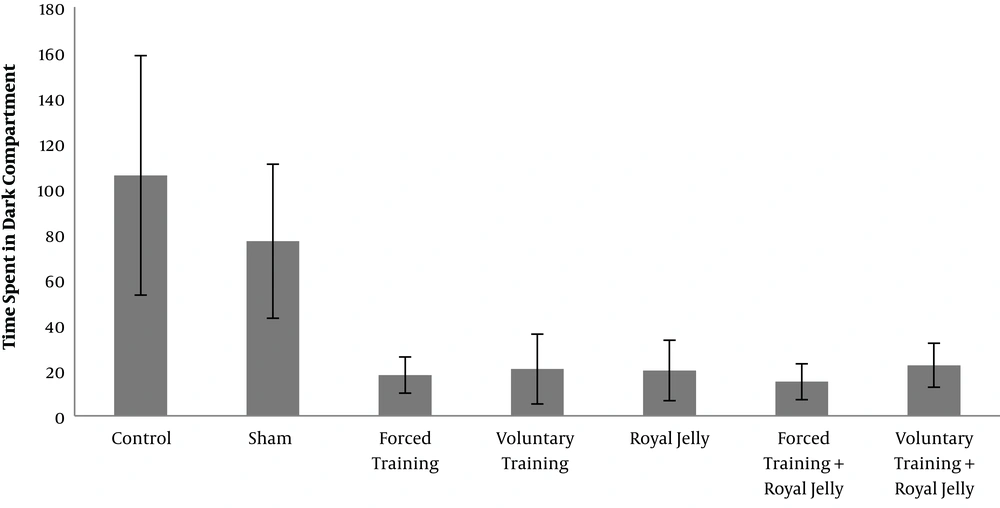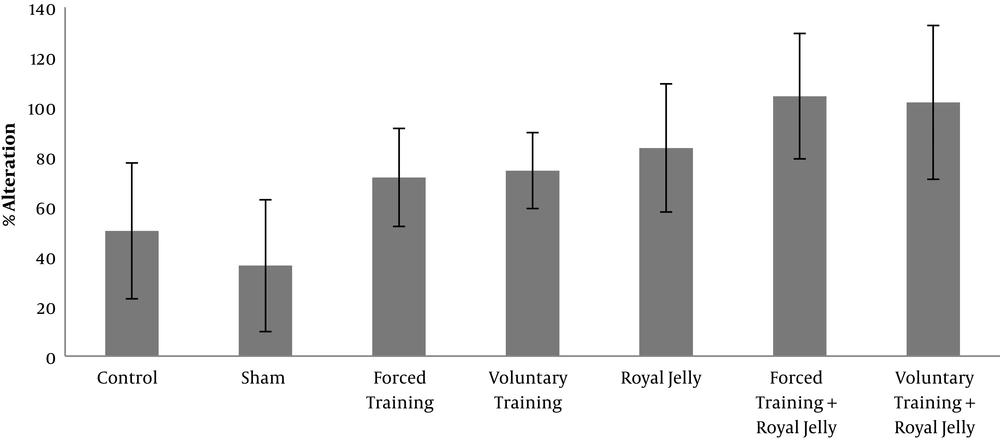1. Background
Alzheimer’s Disease (AD) is affecting more and more people every day (1). According to the World Alzheimer’s Disease Association, AD will affect 80 million people by the year 2040. Researchers believe that the biological mechanisms are involved in the pathophysiology of AD, such as aging, lipoprotein E4 genotype, hypertension, vascular factors, inflammatory markers, dyslipidemia, insulin resistance, and obesity (2).
The use of trimethyltin chloride (TMT) as one of the AD modeling methods has been considered by researchers. Trimethyltin chloride is a neurotoxic substance that selectively induces neuronal death in the limbic system, especially the hippocampal system. In AD, an abnormal accumulation of a protein called β-amyloid has been reported outside the neurons (3). Studies have shown that the accumulation of β-amyloid peptides, synaptic activity damage, and long-term suppression in stimulant synapses can lead to impairment in the learning and memory system. Given that the phenomenon of synaptic facilitation, long-term amplification, and weakening of synaptic activity are the most fundamental mechanisms involved in the formation and consolidation of memory, as well as the hippocampus, by sending some kind of signals to the storage area of long-term memory, that orders to save data. Thus, it plays the main role in providing the stimulus for converting short-term memory into long-term memory (4).
Considering the importance of lifestyle and the increasing prevalence of AD and its effects on memory and learning in the therapeutic strategy of the disease, it is very important to find medicines and therapies that can partly prevent the course of the disease and add to the survival of AD patients (5). It seems that the use of non-pharmacological and non-synthetic methods, due to fewer complications, can improve the memory and the quality of life. It has also been shown that royal jelly (RJ) has different types of biological activity in cells and tissues of animal models (6).
As a liposomal agent, RJ is secreted by the hypopharyngeal and submandibular glands of young working honey bees. In fact, RJ is an essential food for young honey bee larvae and the honey bee queen and it plays an important role in feeding the queen. According to researcher’s reports, RJ may differentiate the types of brain cells, including neurons, from neuronal precursor stem cells (NS/NPCs). Royal jelly or its compounds can facilitate neurogenesis in the DG hippocampus region (7). Much research has been done in this area, often indicating the effectiveness of RJ consumption in memory and learning (8-10).
Today, experts believe that diet and medication alone are not enough to treat and control disorders in patients with AD, but exercise should also be added to the daily schedule of AD patients. Various studies have proven the positive effects of exercise on the improvement of learning (11, 12), memory (7, 12), and cognition (13) in AD. Considering that the available findings are contradictory on the effects of exercises and RJ on learning and memory, especially in AD, it is important to find the best training intensity and nutrition to progress learning and memory in patients with AD. The present study may provide more insights into sports and nutrition science in this field.
2. Objectives
Considering the fact that researchers have been unable to come up with an accurate and effective exercise program to improve AD and since it is important to strengthen and improve the learning and memory in the prevention and treatment of AD and reduce the cost of treatment, the current study aimed to investigate the effect of voluntary and forced training with RJ consumption on learning and spatial memory of rats with AD.
3. Methods
3.1. Setting
The present study was a factorial design study with seven groups. In this experimental study, 56 rats were purchased and transferred to the Exercise Physiology Laboratory of Marvdasht Branch of Islamic Azad University. All rats were kept in standard conditions. On day 8, rats were injected intra-peritoneally with TMT 8 mg/kg (14). After 24 h of ensuring its full effect on the hippocampus, rats with AD were randomly divided into seven groups of eight rats including (1) RJ, (2) voluntary training, (3) forced training, (4) forced training with RJ, (5) voluntary training with RJ, (6) control, and (7) sham.
3.2. Data Collection
Groups 1, 4, and 5 received daily RJ 100 mg/kg (15) peritoneally for eight weeks. Groups 2 and 5 ran on running wheels for eight weeks, three sessions of 60 min per week (16). Groups 3 and 4 swam in a swimming tank for eight weeks, three sessions per week. For swimming training, rats were trained for 5 min in the first week of swimming training, which reached 60 min at the end of the research period (17). It should be noted that the sampling strategy was done according to previous research (17, 18). Twenty-four hours after the last training session, learning and spatial memory were measured by the shuttle box and Y maze, respectively. As the bias could affect the results, in the present study, the researchers attempted to control the selection bias; indeed, the study groups of the present study were matched in all major aspects, except for training and RJ.
3.3. Shuttle Box for Learning Evaluation
First, a rat entered the next chamber, the door was closed, and the rat was immediately withdrawn from the compartment. After 2 min, this trial was repeated. Like the acquisition trial, when the rat entered the dark compartment, the door was closed, and a foot shock was immediately delivered to the grid floor of the darkroom. After 20 s, the rat was removed from the apparatus and placed temporarily in its home cage. Two minutes later, the rat was retested in the same way as in the previous trials. If the rat did not enter the dark compartment in 300 s, the successful acquisition of inhibitory avoidance response was recorded. Otherwise, when the rat entered the dark compartment (before 300 s), for the second time, the door was closed and the animal received the shock again. Twenty-four hours later, each rat was again placed in the light chamber (retention trial); after 5 s, the door was opened and the latency to enter the dark compartment, named Step-Through Latency (STL), and the total Time spent in Dark Compartment (TDC) were recorded in the absence of electric foot shock, as indicators of inhibitory avoidance behavior (18).
3.4. Y Maze Test for Spiritual Memory Evaluation
The Y maze test consisted of three arms made of MDF. Each arm was 46 cm long, 15 cm high, and 15 cm wide, with equal angles to each other. The arms were connected through a central enclosure. To do this test, the rat was first placed at the end of an arm and allowed access to all areas of the maze within a 5-min interval. The frequency of animals entering each arm was observed and recorded. The animal entered the arm when the hind legs of the animal were fully enclosed in the arm; alternating behaviors such as successful and serial entry into all arms in three overlapping sets were intended. Thus, the percentage of alteration (PA) observed to maximum frequency (the total number of arms entered) was multiplied by 100 (19).
3.5. Analytical Methods
The Shapiro-Wilk test was used to check the normal distribution of data. One-way ANOVA was used to assess the effect of RJ and normal saline (RJ solvent). Two-way ANOVA with Bonferroni’s post hoc test was used to assess the effect of training, RJ, and their interaction on research variables in SPSS 20 software (P ≤ 0.05).
4. Results
The data of STL, TDC, and PA are reported in Figures 1-3, respectively. The results of the one-way ANOVA test showed that there were significant differences in STL (P = 0.005), TDC (P = 0.001), and PA (P = 0.006) between the control, sham, and RJ groups. The results of Bonferroni’s post hoc test showed that STL (P = 0.02) and PA (P = 0.04) were significantly higher and TDC (P = 0.001) was significantly lower in the RJ group than in the control group. Nevertheless, there were no significant differences in STL (P = 0.99), TDC (P = 0.39), and PA (P = 0.91) between the control and sham groups.
The results of the two-way ANOVA test showed that training (F = 4.17 and P = 0.02) and RJ (F = 5.98 and P = 0.01) had significant effects on the increase of STL. Nevertheless, the interaction of training and RJ consumption was not significant (F = 1.08 and P = 0.34). Training (F = 18.30 and P = 0.001) and RJ (F = 17.81 and P = 0.001) had significant effects on the decrease of TDC. Also, the interaction of training and RJ was significant in the increase of TDC (F = 17.08 and P = 0.001). Training (F = 3.97 and P = 0.02) and RJ (F = 19.28 and P = 0.001) had significant effects on the increase of PA. Nevertheless, the interaction of training and RJ was not significant (F = 0.07 and P = 0.93) (Table 1).
| Variables/Source | Sum of Squares | df | Mean Square | F | Sig. | Partial Eta Squared |
|---|---|---|---|---|---|---|
| STL | ||||||
| Training | 16723.29 | 2 | 8361.64 | 4.17 | 0.02a | 0.16 |
| RJ | 11989.04 | 1 | 11989.04 | 5.98 | 0.01b | 0.12 |
| Interaction of Training and RJ | 4353.47 | 2 | 2176.73 | 1.08 | 0.34 | 0.04 |
| TDC | ||||||
| Training | 20818.69 | 2 | 10409.34 | 18.30 | 0.001c | 0.46 |
| RJ | 10127.41 | 1 | 10127.41 | 17.81 | 0.001d | 0.29 |
| Interaction of Training and RJ | 19427.84 | 2 | 9713.92 | 17.08 | 0.001e | 0.44 |
| PA | ||||||
| Training | 4780.30 | 2 | 2390.15 | 3.97 | 0.02a | 0.15 |
| RJ | 11591.90 | 1 | 11591.90 | 19.28 | 0.001b | 0.31 |
| Interaction of Training and RJ | 84.27 | 2 | 42.13 | 0.07 | 0.93 | 0.003 |
The Results of Two-way ANOVA for Effects of Training and RJ on STL, TDC, and PA in Rats with AD
The results of Bonferroni’s post hos test showed that forced training had a significant effect on the increase of STL (P = 0.02). Nevertheless, voluntary training had no significant effect on STL (P = 0.99). Forced training (P = 0.001) and voluntary training (P = 0.001) had significant effects on the decrease of TDC while forced training and voluntary training had the same effect on the decrease of TDC (P = 0.99). Forced training (P = 0.04) and voluntary training (P = 0.04) had significant effects on the increase of PA and forced training and voluntary training had the same effect on the increase of PA (P = 0.99).
5. Discussion
In this study, eight weeks of forced training significantly increased STL and PA and decreased TDC. Voluntary training had significant effects on the decrease of TDC and the increase of PA in rats with AD. The results confirmed that forced training and voluntary training could improve learning and spiritual memory in rats with AD. In line with the present study, Jiangbo and Liyun showed that four weeks of aerobic training improved the learning and memory function of rats with AD. They stated that the mechanism was related to the improved morphological structure of hippocampal neurons, reduced loss of neuronal cells, increased choline acetyltransferase (ChAT) content, and decreased acetylcholinesterase (AchE) content (12). Dao et al. reported that four weeks of running with the intensity of 15 m/min significantly increased Brain-derived Neurotropic Factor (BDNF) and levels of memory; they finally concluded that endurance training could prevent cognitive impairment in rats with AD (7). Lin et al. stated that training could modulate angiogenesis and glial activation, which could support neuroplasticity (11).
It has been reported that exercise can induce long-term potentiating in different areas of the hippocampus. Exercise enhances memory and learning through mechanisms such as increased levels of BDNF as the mediator of synaptic effects, neural connections, and plasticity in the brain. Exercise also improves nerve cell function by proliferating cells in the hippocampus, inhibiting apoptosis in the hippocampal dentate gyrus, and enhancing the synaptic space in different parts of the brain. In addition, researchers believe that increased neurogenesis and plasticity are mechanisms to increase memory and improve nervous system function (20).
According to the results of the present study, eight weeks of RJ consumption significantly increased STL and PA and reduced TDC in rats with AD. In this regard, Zamani et al. reported that the consumption of food that contained 3% RJ for 10 days improved learning and memory; finally, they concluded that RJ could improve cognitive processes by exerting positive effects on neural functions and therapy and preventing some neuronal disorders (21). In line with the present study, Sofiabadi et al. showed that 30 days’ consumption of RJ (100 and 200 mg/kg) significantly reduced TDC in rats; nevertheless, RJ at 50 mg/kg had no significant effect on TDC (22). It appears that the effects of RJ on memory can be dose-dependent. Studies have shown that conditions that increase neurogenesis or inhibit neuronal death under different pathological or physiological conditions in the hippocampal dentate gyrus actually improve learning and memory processes (21). It is known that 10-hydroxy-trans-2-decenoic acid (HDEA) is one of the unique constituents of RJ (21). As HDEA is a small unsaturated fatty acid molecule, it can cross the blood-brain barrier. It has been shown that HDEA mimics the effects of BDNF and possibly stimulates neurogenesis in the adult brain (21). Oxidative stress is one of the factors that play a key role in the pathogenesis of the aging process and neurodegenerative diseases. It is reported that RJ has the potential to inhibit free radicals and it is a very useful and effective antioxidant. Moreover, RJ has also shown to inhibit the peroxidase process in vivo and in vitro (23).
In the present study, training and RJ consumption had significant interactive effects on the decrease of TDC; nevertheless, they had no significant interactive effect on the increase of STL and PA in rats with AD. Despite that studies reported the effects of RJ and exercise separately on learning and memory in human and animal models, no research was found to assess the effects of training simultaneously with RJ consumption on learning and memory in AD. It appears that training and RJ consumption improve learning and spiritual memory with different mechanisms, but the present study showed that using these two factors together reduced TDC in rats with AD. However, further studies are needed to understand the interactive effects of training and RJ consumption. As most research has examined the protective effects of training and RJ consumption alone on learning and memory in patients with AD, the novelties of this study were the assessment of the interactive effects and the simultaneous administration of training and RJ consumption. Considering the physiological effects of exercise and RJ, the limitation of this study seems to be the lack of evaluation of physiological changes in the central and peripheral nervous systems related to learning and memory, such as muscle mass, strength, balance, and neurotrophins. Therefore, in future studies, it is proposed to measure these physiological indicators along with learning and memory. Also, as previous research reported the effects of training and RJ consumption on learning and memory separately, assessing and comparing the effects of voluntary and forced training and RJ consumption on learning and memory can be the strengths of this study.
5.1. Conclusions
According to the results of the present study, although training and RJ alone could improve memory and learning, it appears that training simultaneously with RJ consumption has interactive effects on improving memory in rats with AD.



